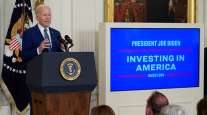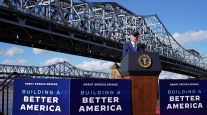Opinion: Infrastructure — A Pivotal Moment
By James Corless
Director
Transportation for America
This Opinion piece appears in the May 9 print edition of Transport Topics. Click here to subscribe today.
This is a pivotal moment for our nation’s commitment to investing in transportation infrastructure. The Interstate Highway System has been built, but it no longer meets all our needs and is showing its age.
The next transportation bill must address the many challenges our nation is facing:
• Crippling commutes.
• Rising costs.
• Wasteful spending.
• Lack of options.
• The need for economic development in urban, suburban and rural communities alike.
However, to build an effective 21st-century transportation system, we first must understand how we got here and why.
The story begins in 1919, when future Army general — and president — Dwight D. Eisenhower made a 3,000-mile cross-country trip on the Lincoln Highway, which ran between New York City and San Francisco. The trip included unpaved roads that literally shook vehicles to pieces and bridges so rickety that fording a stream was often the safer choice. It made an unforgettable impression on the youthful Eisenhower.
The next act is in Europe, where Gen. Eisenhower led U.S. troops in World War II and got a good look at the famed German autobahn, a broad national network of four “superhighways.”
With these earlier experiences in mind, President Eisenhower in 1956 became the “Father of the Interstate System” by signing the Interstate and Defense Highways Act, which offered a plan to build 41,000 miles of multilane, limited-access highway.
Originally intended as a system to connect economic centers and link states together, the interstates radically transformed the travel and development patterns within cities themselves and helped facilitate the booming growth of the nation’s suburbs. While urban highways were built with as much as 90% federal money, no similar program existed for nonhighway networks or for public transportation.
Then, in the early 1980s, Congress took steps to unify highway, transit and transportation safety programs under the Surface Transportation Assistance Act of 1982 and — with President Reagan’s support and leadership — raised the gas tax from 4 cents to 9 cents and dedicated 1 cent per gallon exclusively for public-transit programs for the first time.
Finally, fast-forward several decades to 2005, when President George W. Bush signed the current transportation law, known as SAFETEA-LU — the Safe Accountable Flexible Efficient Transportation Equity Act: A Legacy for Users.
SAFETEA-LU allocated $228 billion for highway programs and $53 billion for transit programs. The bill expired Sept. 30, 2009, but has been extended multiple times since that date.
Today, there is widespread agreement on the need for a new direction in federal policy to address the many challenges we face. While the interstate system was built substantially with gasoline taxes, it cannot be said that the system is “paid for.” As it ages — many bridges, for example, are at or near their 50-year design life — the costs required to rebuild and maintain the system are mounting.
Many issues and challenges with the current policy had become widely acknowledged starting in 2005, when Congress created three national commissions in the SAFETEA-LU authorization to study options and opportunities to reform transportation policy.
Numerous other organizations, including the U.S. Government Accountability Office, the Congressional Research Service, the Bipartisan Policy Center, the Miller Center for Public Affairs and the Brookings Institution, also have published analyses of the current situation. While the emphasis of these analyses varies, the conclusions about the need for change do not. All agree:
• The next bill must express a national vision and set clear goals that move our surface transportation program forward and direct limited federal funds to broaden our transportation system and develop a network that meets the needs of the 21st century.
• Federal transportation money cannot continue to be distributed with little or no accountability for performance. Congress must restore voters’ confidence that spending on transportation will improve conditions, build the system we need and make progress on established national goals.
• The current funding and financing structures of the federal transportation program do not reflect new realities in the demand and means of travel today.
• The institutions created to manage the transportation system and the governments created to oversee decision-making surface transportation programs often do not employ the best tools and approaches to ensure effective investment decisions.
This year’s upcoming authorization offers the opportunity to fix these issues while growing the economy, increasing access to jobs and protecting human health and the environment. The transportation network does more than just move people: It provides the very framework around which we build our economy and our communities. Now is the time to renew or sense of purpose and refocus our policies to get the job done for the 21st century and beyond.
Transportation for America, Washington, D.C., is a diverse coalition of more than 400 national, state and local private and government organizations working for a new national transportation policy.




